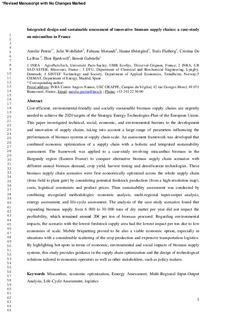| dc.description.abstract | Cost-efficient, environmental-friendly and socially sustainable biomass supply chains are urgently needed to achieve the 2020 targets of the Strategic Energy Technologies-Plan of the European Union. This paper investigated technical, social, economic, and environmental barriers to the development and innovation of supply chains, taking into account a large range of parameters influencing the performances of biomass systems at supply chain scale. An assessment framework was developed that combined economic optimization of a supply chain with a holistic and integrated sustainability assessment. The framework was applied to a case-study involving miscanthus biomass in the Burgundy region (Eastern France) to compare alternative biomass supply chain scenarios with different annual biomass demand, crop yield, harvest timing and densification technologies. These biomass supply chain scenarios were first economically optimized across the whole supply chain (from field to plant gate) by considering potential feedstock production (from a high-resolution map), costs, logistical constraints and product prices. Then sustainability assessment was conducted by combining recognized methodologies: economic analysis, multi-regional input-output analysis, emergy assessment, and life-cycle assessment. The analysis of the case study scenarios found that expanding biomass supply from 6,000 to 30,000 tons of dry matter per year did not impact the profitability, which remained around 20€ per ton of biomass procured. Regarding environmental impacts, the scenario with the lowest feedstock supply area had the lowest impact per ton due to low economies of scale. Mobile briquetting proved to be also a viable economic option, especially in situations with a considerable scattering of the crop production and expensive transportation logistics. By highlighting hot-spots in terms of economic, environmental and social impacts of biomass supply systems, this study provides guidance in the supply chain optimization and the design of technological solutions tailored to economic operators as well as other stakeholders, such as policy makers. | nb_NO |
